Bioland Technology BGMB002 Blood Glucose Meter User Manual
Bioland Technology Ltd. Blood Glucose Meter
User Manual
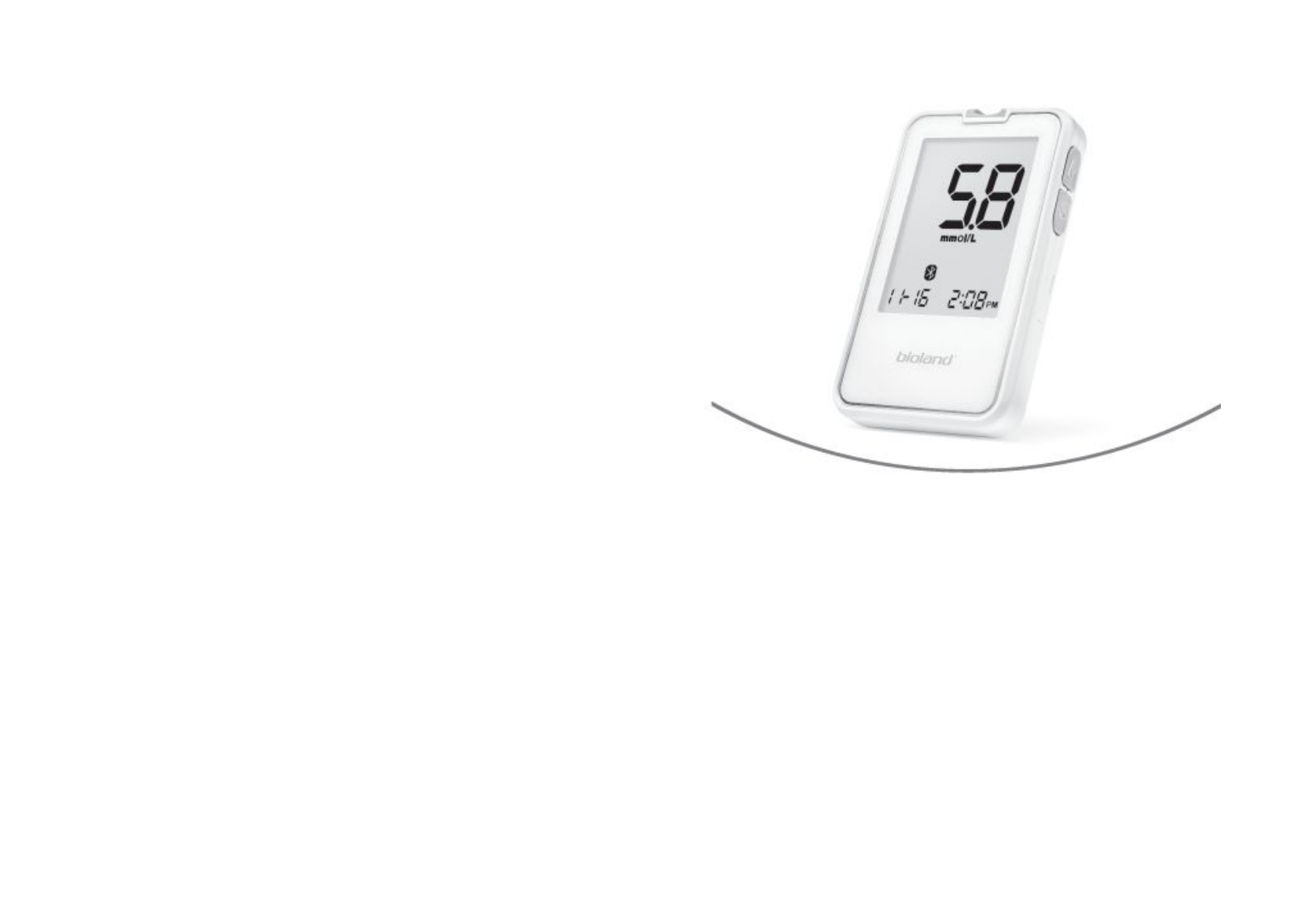
Bioland
®
Blood Glucose
Meter
Model
:
G-427B
Manufacturer:
BIOLAND TECHNOLOGY LTD.
A6b7 (Block G), Shangrong Ind. Zone, Baolong 5th Rd, Longgang
Distinct, Shenzhen Guangdong, CHINA 518116
G-427B
Blood Glucose Meter
User Manual

Page 1 of 19
Dear G-427B Blood Glucose Monitoring System Owner:
Thank you for choosing this
system!
This manual contains important information you
must
know about the
system.
Please read it thoroughly and
carefully.
The system provides
No Code function
which means that
you don't need
to
calibrate your
metermaking
it
easier
for the user
to
monitor blood glucose at
home.
Important safety instructions
The meter and lancing device are for single patient use. Do not share them
with anyone including other family member! Do not use on multiple
patients!
All parts of the kit are considered biohazardous and can potentially
transmit infectious diseases even after you have performed cleaning and
disinfection.
Changes or modifications not expressly approved by the party responsible
for compliance could void the user’s authority to operate the equipment.
Read this before using
DANGER - Misuse of this electrical device can cause electrocution, burns, fire
and other HAZARDS.
Basic safety precautions should always be taken, including all those listed
below.
Close supervision is necessary when equipment is used by, on, or near children,
handicapped persons or invalids.
The following basic safety notice should always be taken:
1. Do not place the device in liquid, nor put it where it could fall into liquid.
2. The following basic safety notice should always be taken.
3. Use the device only for the intended use described in this manual.
4. Do not use adjunct which are not supplied by the producer.
5. Do not make the device come into contact with surfaces which are too hot to
touch.
6. Do not use the device where aerosol sprays are being used.
7. Do not use the device if it is not working properly, or if it has been damaged.
8. Read all the manual, and practice the test, and then use the product to test
your blood glucose. Do all quality control checks as directed and consult with a
diabetes expert.
KEEP THESE INSTRUCTION IN A SAFE PLACE
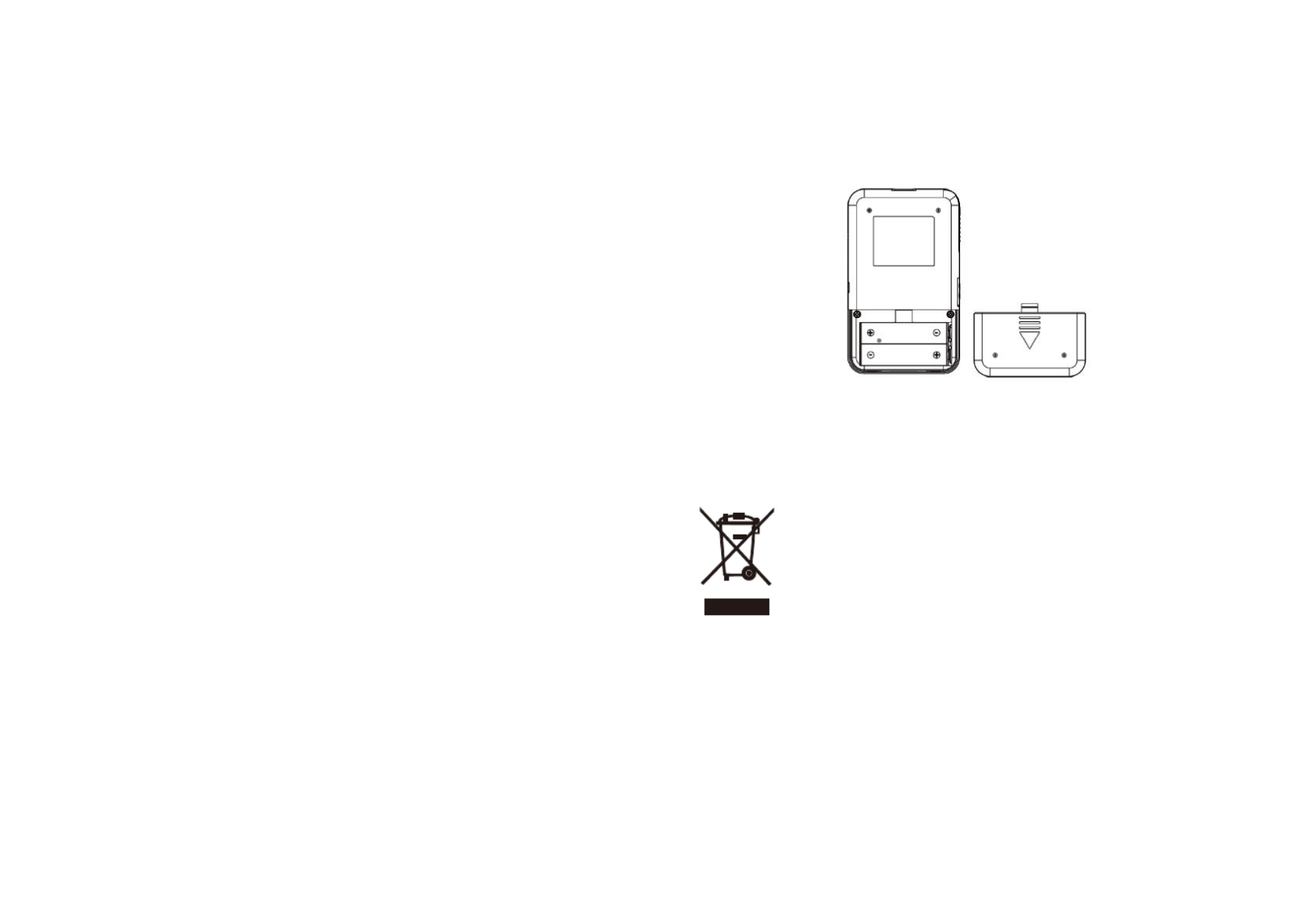
Page 2 of 19
BeforeYour Begin
Installing the battery
1. Open the battery cover on the back of meter.
2. If replacing the batteries, please remove the used batteries.
3. Insert 2 new (AAA) batteries with correct +/- direction.
4. Close the battery cover.
Environment Protection – Waste electrical products should not be disposed of
with household waste. Please recycle where facilities exist. Check with your
local Authority or retailer for recycling advice.

Page 3 of 19
INTRODUCTION TO THE SYSTEM
ABOUT YOUR SYSTEM
Intended Use
The G-427B Blood Glucose Monitoring System is intended for use in the
quantitative measurement of glucose in capillary whole blood from the
finger. It is intended for use by people with diabetes mellitus at home as an
aid in monitoring the effectiveness of a diabetes control program. The
G-427B Blood Glucose Monitoring System intended to be used by a single
person and should not be shared.
The Blood Glucose Monitoring System is intended for self-testing outside
the body (in vitro diagnostic use) by people with diabetes at home as an
aid to monitor the effectiveness of diabetes control. The Blood Glucose
Monitoring System is not to be used for the diagnosis of or screening of
diabetes, or for neonatal use.
The Test Strips are for use with the Blood Glucose Meter to quantitatively
measure glucose drawn from the fingertips.
The control solutions is intended for use with the system, to check that the
glucose meter and test strips are working properly and that you are doing
the test correctly. The solutions contain a known range of glucose, as
indicated on the strips vial bottles.
Warnings
The system is intended for use outside the body (in vitro diagnostic use). It
is for single-patient use. It should be used only for testing glucose (sugar)
and only with fresh capillary whole blood samples taken from the finger.
The system is intended for use at home. It should not be used for the
diagnosis of diabetes or for the testing of newborns.
The System is intended for self-testing outside the body (in vitro
diagnostic use) by people with diabetes at home as an aid to monitor the
effectiveness of diabetes control. Alternative site testing should be done
only during steady – state times (when glucose is not changing rapidly).
The G-427B blood glucose test strips are for use with the Blood Glucose
Meter to quantitatively measure glucose in fresh capillary whole blood
samples drawn from the fingertips.
The Taidoc control solutions is intended for use with the System, to check
that the glucose meter and test strips are working properly and that you are
doing the test correctly. These solutions contain a known range of glucose,
as indicated on the strips vial bottles.
This device is not intended for use in healthcare or assisted-use settings
such as hospitals, physician’s offices, or long-term care facilities
because it has not been determined to be safe and effective for use in
these settings, including for routine assisted testing or as part of
glycemic control procedures.
Use of this device on multiple patients may lead to transmission of
Human Immunodeficiency Virus (HIV), Hepatitis C Virus (HCV),
Hepatitis B Virus (HBV), or other bloodborne pathogens.
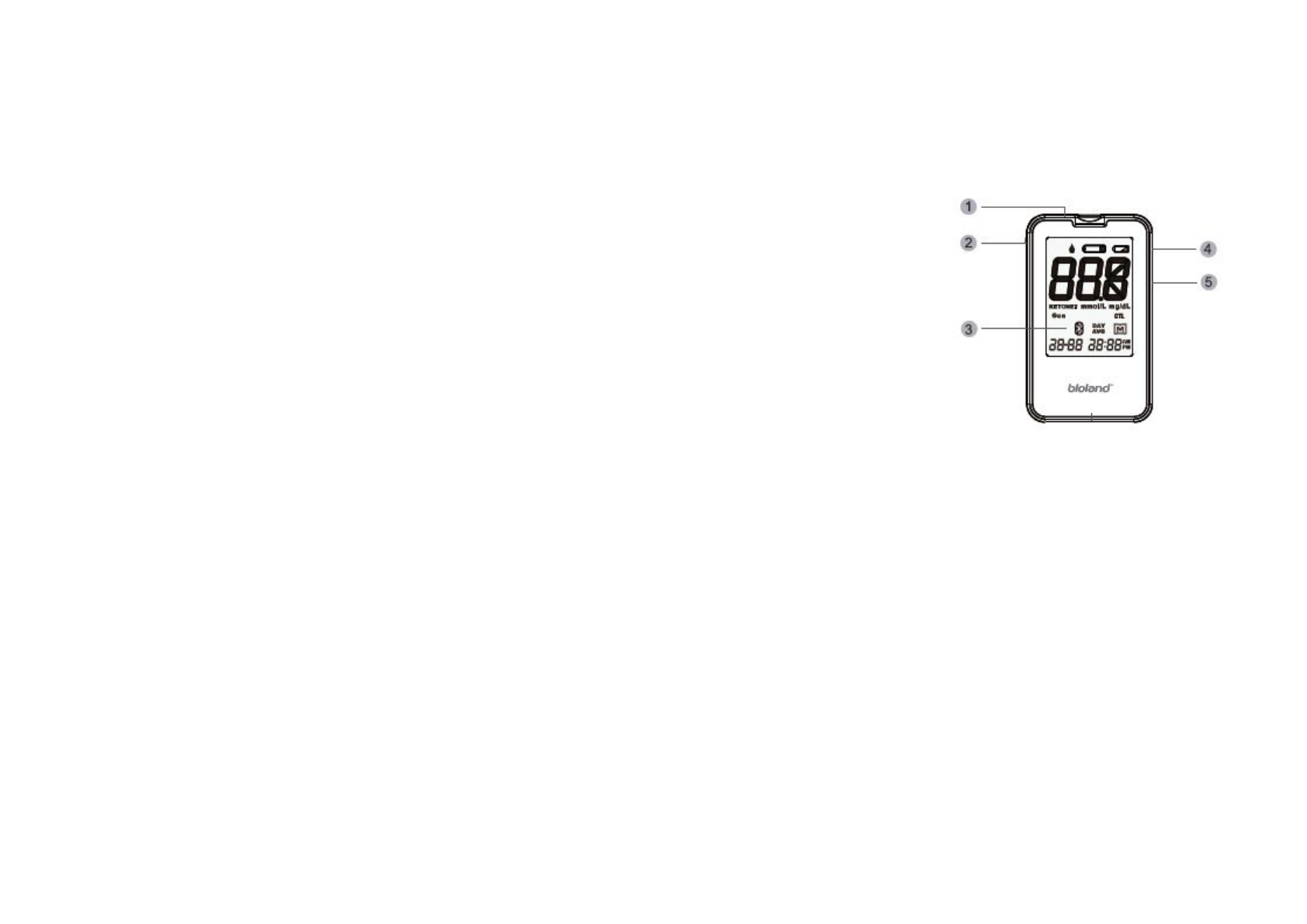
Page 4 of 19
Test principle
The test is based on the measurement of electrical current generated by the
reaction of glucose with the reagent of the strip. The meter measures the current
and displays the corresponding blood glucose level. The strength of the current
produced by the reaction depends on the amount of glucose in the blood
sample.
Contents of the kits
A Meter
Owner’s Manual
Two AAA Alkaline Batteries
Test Strips (Optional)
Lancing Device
Sterile Lancet (Optional)
TaiDoc Control Solution (Optional)
NOTE:
The Lancing Device can be used for several times, however the sterile
lancet should be changed after each use.
Sterile lancet and control solution are not included in the standard kit.
There are three levels for the control solutions: low, normal and high
available, please contact the place of purchase for more information.
If any items are missing from your kit or opened prior to use, please contact
local customer services or place of purchase for assistance.
Blood Glucose Meter
1. Strip port
Where you insert the test strip into
strip port, the meter will turn on
automatically.
2. Strip ejector
Slide forward to eject the test strip
after test.
3. LCD Display
It guides you through the test using
symbols and simple messages
4. "M" Button
It is used to turn on the meter enter
the memory mode
5. "S" Button
It is used to set up the meter
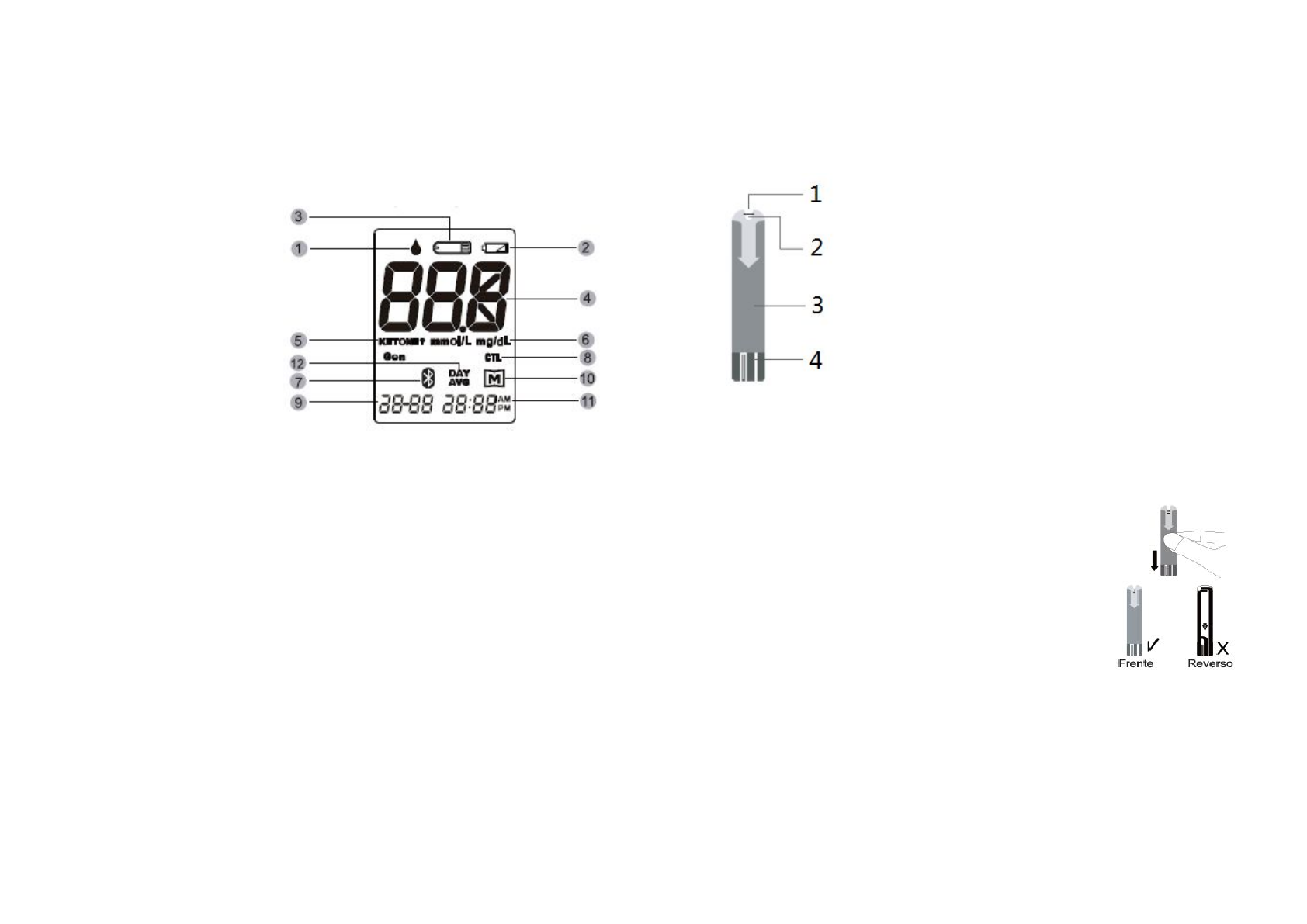
Page 5 of 19
Meter Screen Display Message
1) Blood drop
symbol
Flashes when it is
ready to apply the
blood sample.
2) Low battery
symbol
Appears when the
battery power is
low.
3) Test strip symbol
Appears when the
meter is turned
on.
4) Test result area
Displays glucose
results
5) Measurement unit
Appears with the test result in mg/dL
6) Bluetooth Symbol
7) CTL symbol
Appears when doing a control test and indicates that the result won’t be
stored in the memory
8) Date
9) Memory symbol
Appears when you review the memory
10) Time
11) Day average
Indicate that the displayed test result is an average value
Test Strip
Each strip can be used only once. The test strip consists of the following parts:
1-Absorbent hole
Apply a drop of blood here. The blood will be drawn in
automatically.
2-Confirmation window
This is where you confirm if enough blood has been
drawn into the absorbent hole of the strip.
3-Test strip handle
Hold this part to insert the test strip into the slot.
4-Contact bars
Insert this end of the test strip into the meter. Push it in
firmly until it will go no further.
Attention!
Test results might be wrong if the contact Bar is not fully
inserted into the test slot.
The front side of the test strip should face up when
inserting the test strip.
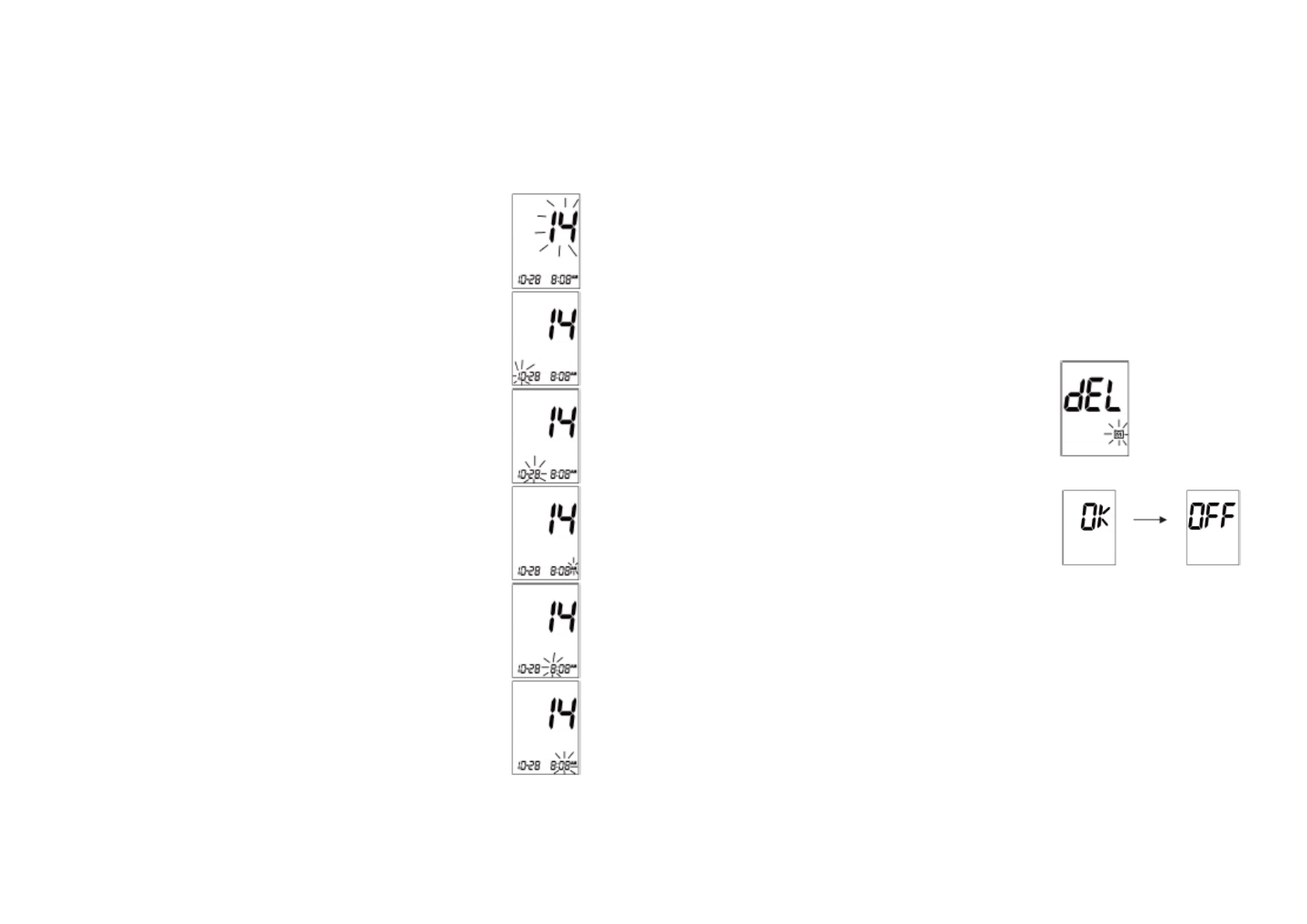
Page 6 of 19
Setting the meter and deleting the memory
1. Setting the date and time
1.1 Setting the Year
Press and Hold “S” button for 3 seconds, until the last two
digits of the year will flash on the screen (for example, “14”
equals 2014). Press “M” button until the correct year
appears. Press “S”.
1.2 Setting the month
With the month flashing, press “M” until the correct month
appears. Press “S”.
1.3 Setting the day
With the day flashing, Press “M” until the correct day
appears. Press “S”.
1.4 Setting the AM/PM
With the AM or PM flashing, Press “M” until the correct
one appears. Press “S”.
1.5 Setting the hour
With the hour flashing, Press “M” until the correct hour
appears. Press S“.
1.6 Setting the minute
With the minute flashing, Press “M” until the correct
minute appears. Press “S”.
2. Set the unit
(mg/dL or mmol/L)
2.1 mg/dL → mmol/L
With the “mg/dL” displaying, press “M” button until
the “mmol/L” appears, press “S” button twice again
until the meter turn off.
2.2 mmol/L → mg/dL
With the “mmol/L” displaying, press “M” button
until the “mg/dL” appears, press “S” button twice
again until the meter turn off.
Deleting the Memory
Press “S” then “dEL” will display with flashing “M”.
Press “M” once, to confirm delete, press “M” button
again to delete ALL memory. The meter then
displays “OK”, which means that the memory is
deleted. If you don’t want to delete the memory,
press the S button to skip this step. The meter will
automatically turn “OFF”, and the set up will be
completed.
NOTE:
The date, time, unit and memory deletion can ONLY be set in the setting
mode.
When the meter is in setting mode, if no button is pressed within 3 minutes,
the meter will turn off.
No set up necessary, meter is pre-set. Meter is pre-set for Eastern Standard
Time. Please refer to page 13 of this manual for set up instruction.
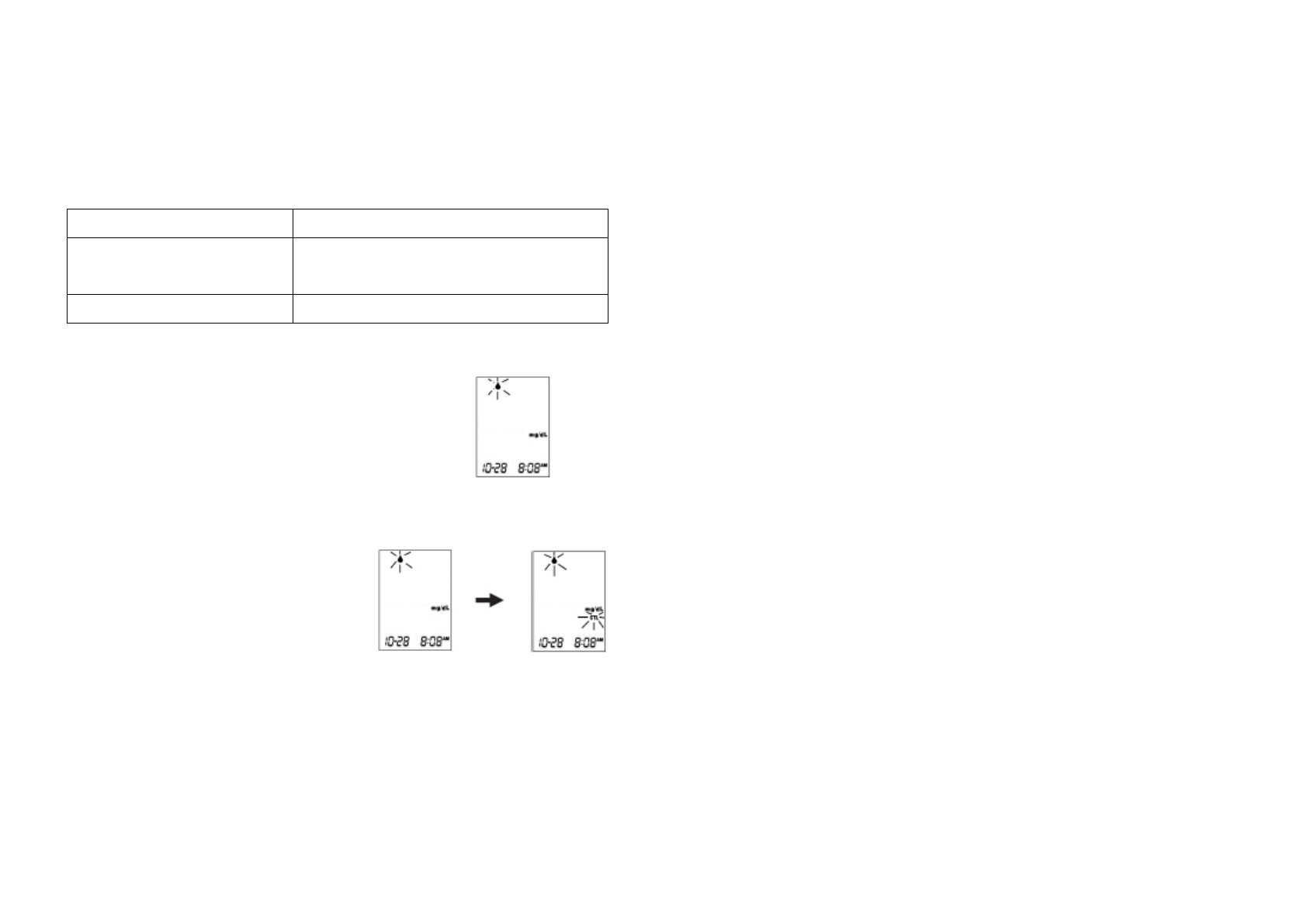
Page 7 of 19
The two measuring modes
The meter provides you with two modes for measuring, General and CTL. The
CTL mode should be used when a control solution is being tested. See the table
below.
Modes
Use when
General test (not display)
Any time of day without regard to time
since last meal
CTL
Testing with the control solution
You can switch between each mode by:
1. Start with the meter turned off. Insert a test
strip to turn on the meter, the screen will
display a flashing blood drop and Bluetooth
symbol, time and date.
2. Press “S” to select General or CTL mode.
Testing with blood sample
CAUTION:
To reduce the chances of infection:
Choose a clean, dry work surface.
Never share a lancing device and lancet with another person.
Always use a new and sterile lancet. Lancets are for single use only.
Always use a new test strip. Test strip are for single use only.
Avoid getting lotion, oils, dirt or debris in or on the lancet and lancing
device.
Note:
Before testing, please read the following steps thoroughly and carefully,
please relax and do the test step by step. Simplifying or changing the test
procedure may produce inaccurate results.
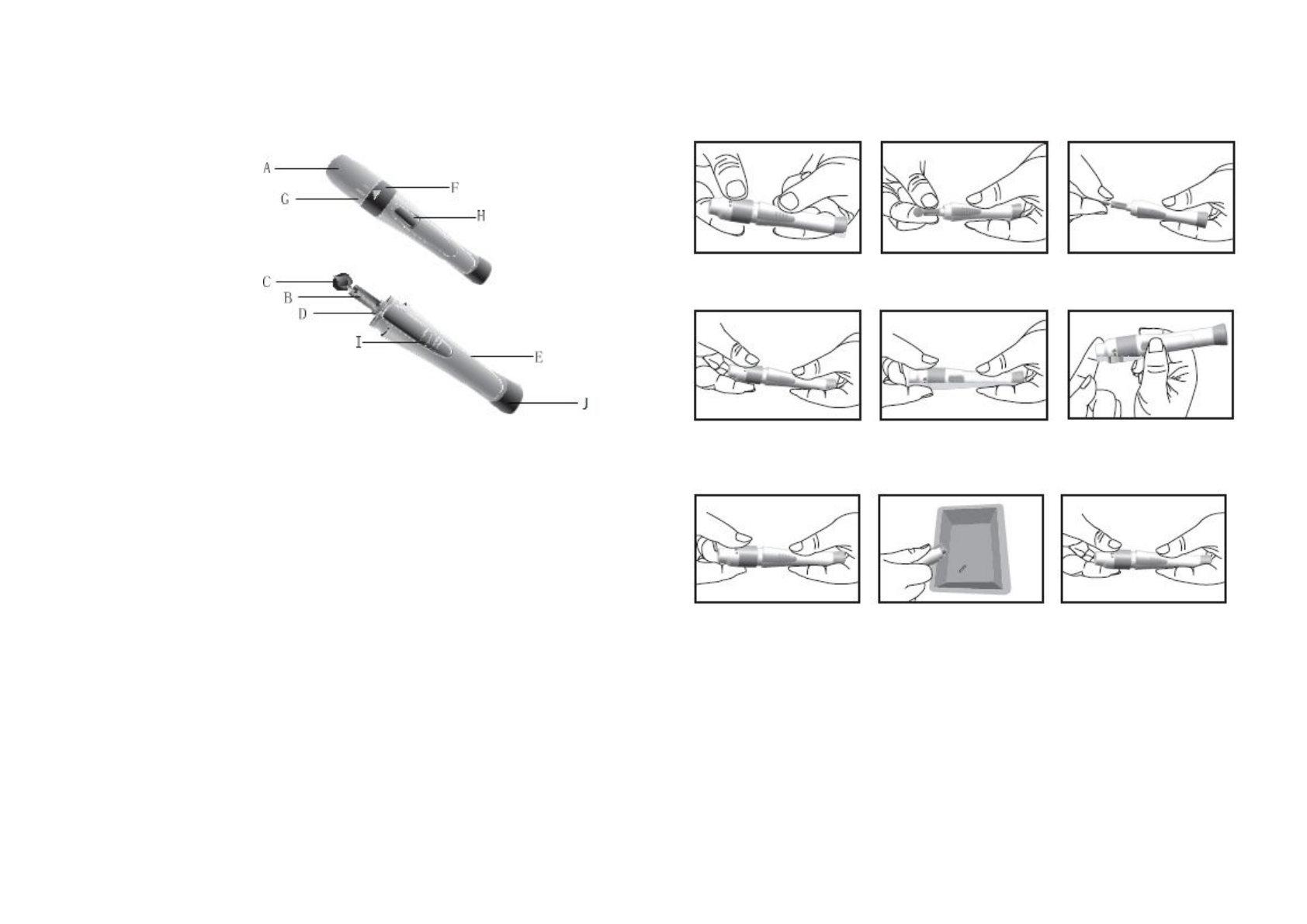
Page 8 of 19
Overview of the Lancing Device
A. Device Cap
B. Handle
C. Needle Cap
D. Needle Holder
E. Device Body
F. Connecting Collar
G. Adjustable tip
H. Release Button
I. Ejection Button
J. Device control cap on
the lancets and the
lancing device.
If your lancing device differs from the one shown here, please refer to the
manufacturer’s manual to ensure proper usage.
NOTE:
To reduce the chance of infection:
Never share a lancet or the lancing device.
Always use a new, sterile lancet. Lancets are for single use only.
Avoid getting hand lotion, oils, dirt, or debris when handling the lancets.
Setting Up the Lancing Device
1. Screw the device cap off.
2. Put the needle into the
needle holder until the
bottom.
3. Screw the needle cap and
put it in the recycling
dustbin.
4. Cover the cap
5. Adjust the proper level
(usually level 3)
6. Aiming at the sterilized
part for blood-taking, press
the blue release key to finish
blood taking.
7. Screw the device cap.
8. Push the ejection button
and discard the used lancet
in appropriate container.
9. Cover the device cap.
NOTE:
The adjustable tip offers 5 levels of skin penetration. Twist the adjustable tip to
the proper level:
1-2 level for soft or thin skin
3 level for average skin
4-5 level for thick or calloused skin
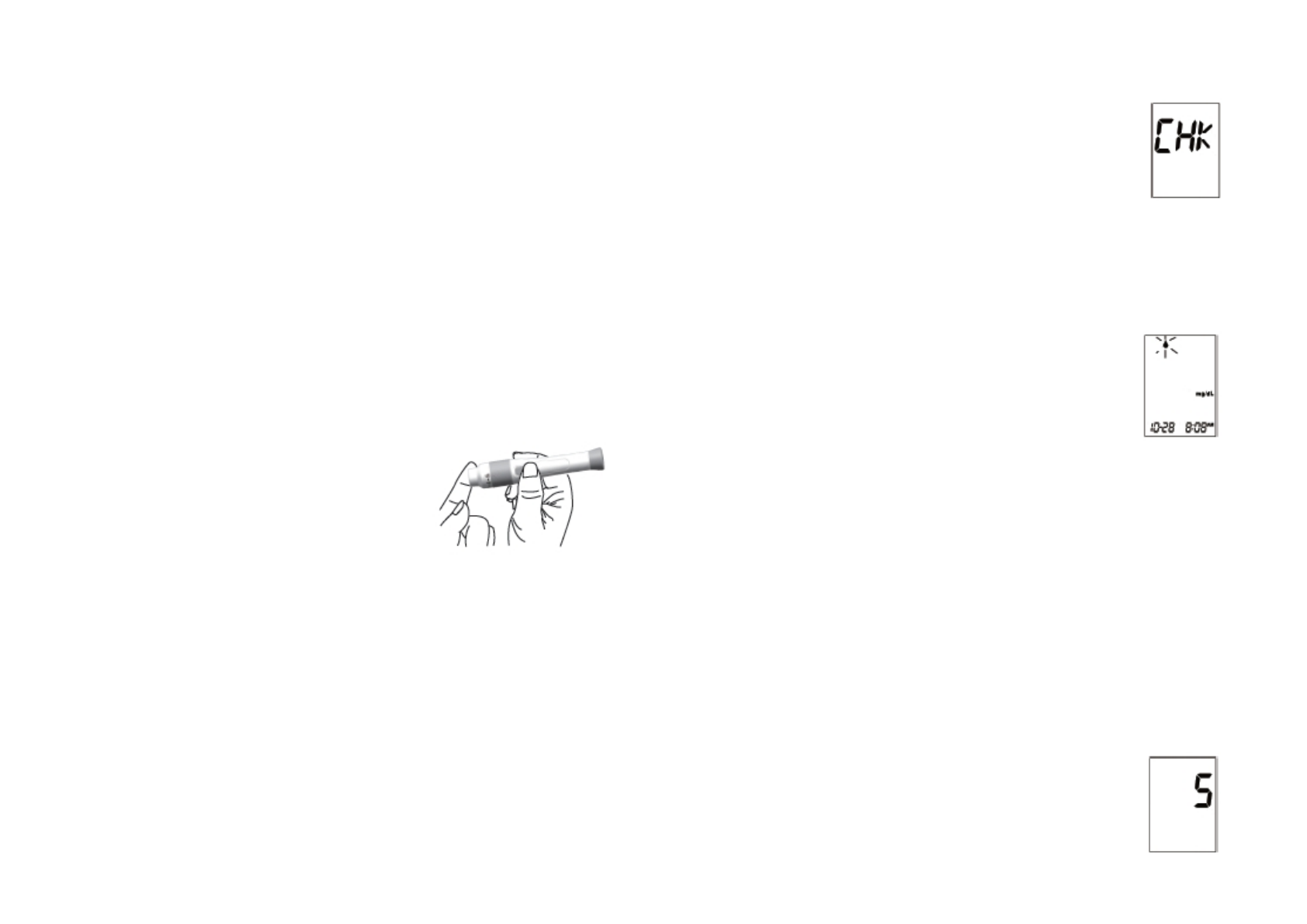
Page 9 of 19
Preparing the puncture site
Stimulating blood perfusion by rubbing the puncture site prior to blood
extraction has a significant influence on the glucose value obtained. Blood from
a site that has not been rubbed exhibits a measurably different glucose
concentration than blood from the finger. When the puncture site was rubbed
prior to blood extraction, the difference was significantly reduced.
Please follow the suggestions below before obtaining a drop of blood:
Rub the puncture site for about 20 seconds before penetration.
Select the puncture site at the fingertips.
Clean the puncture site using cotton moistened with 70% alcohol and let it
air dry.
Fingertip testing
Hold the lancing device firmly against the side of
your finger. Press the release key. You will hear a
click, indicating that the puncture is complete.
NOTE:
Choose a different spot each time you test. Repeated punctures at the same
spot may cause soreness and calluses.
It is recommended to discard the first drop of blood as it might contain
tissue fluid, which may affect the test result.
Performing a Blood Glucose Test
Step 1
Wash hands with soap and warm water.
Step 2
Remove a test strip from its vial. With clean, dry hands, you may touch the test
strip anywhere on its surface. Do not bend, cut or modify the test strips in any
way. Remove the test strip from the vial and use it instantly.
Step 3
Insert the test strip into the meter's test port and the meter is
turned on. The screen will display a flashing blood drop and
Bluetooth symbol, time and date.
NOTE: Be sure to use G-427B blood glucose test strips, other
test strips may not produce an accurate result.
Step 4
When the blood drop symbol flashes on the screen, you may select
the appropriate measurement mode, for selecting the measurement
mode of Control (CTL) or General, please refer to the “The two
measuring modes” section.
Step 5
Apply your blood to the absorbent hole of the test strip. For collecting blood
sample, please refer to the “Preparing the puncture site” section.
Step 6
As soon as enough blood has filled the confirmation window of the
test strip, you will hear a beep letting you know the test has begun.
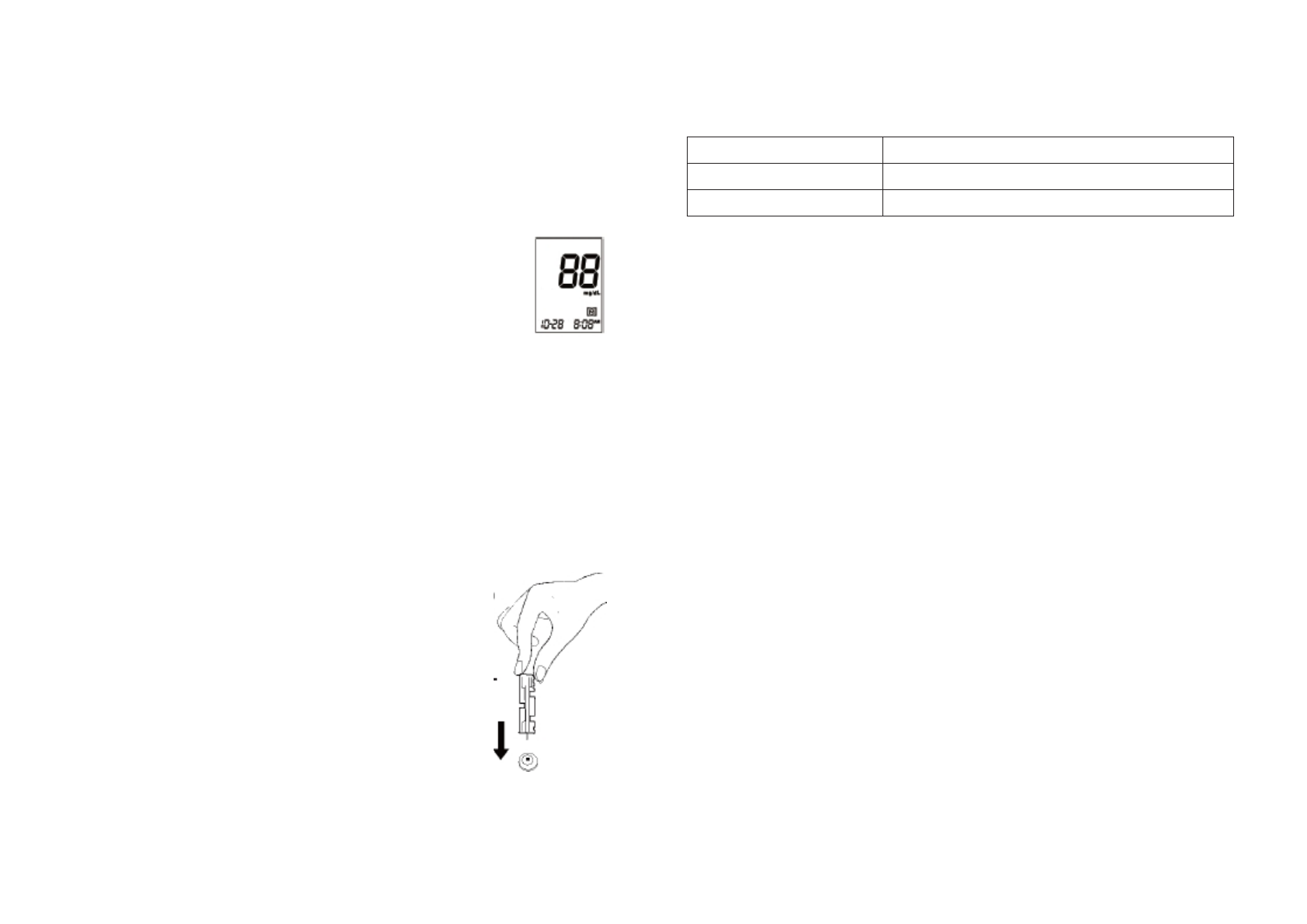
Page 10 of 19
A countdown of 5 seconds starts.
Note: make sure the confirmation window of the Test Strip is completely filled
with your blood sample.
Step 7
Your blood glucose level, along date and time appears on the
display. Blood glucose results are automatically stored in the
memory.
When Bluetooth connected, Bluetooth symbol flashing, and
waiting for other device with Bluetooth to scan and connect, then
upload the test results date.
NOTE:
The results obtained from this meter are plasma-calibrated. This helps you and
your physician or other qualified healthcare provider to compare your meter
results with laboratory tests. Reference to the instructions given by your
physician or other qualified healthcare provider, do not deviate from these
instructions on the basis of the result without first consulting your physician.
Step 8
Eject the used test strip and remove the lancet. To eject the
test strip, point the strip at a disposal container for sharp
objects. The meter will switch itself off automatically after
the test strip is ejected.
Please wash hands thoroughly with soap and water after
handling the meter, lancing device, or test strips.
Reference value
Time of day
Normal plasma glucose rang for people without
diabetes
Before breakfast (fasting)
<100 mg/dL
Two hours after meals
<140 mg/dL
Source: American Diabetes Association. Standards of Medical Care in
Diabetes-2012.Diabetes Care 2012,35(Suppl.1) S11-S63.
Note: Please work with your doctor to determine a target range that works best
for you.
Comparing Meter and Laboratory Results
The meter provides you with whole blood equivalent results. The result you
obtain from your meter may differ somewhat from your laboratory result due to
normal variation. Meter results can be affected by factors and conditions that do
not affect laboratory results in the same way. To make an accurate comparison
between meter and laboratory results, follow the guidelines below.
Before going to the lab:
Do a control solution test to make sure that the meter is working properly.
Fast for at least eight hours and then do comparison tests, if possible.
Take your meter with you to the lab.
While staying at the lab:
Make sure that the samples for both tests are taken and tested within 15 minutes
of each other.
Wash your hands and then obtain a blood sample
Never use your meter with blood that has been collected in a gray top test
tube.
Use fresh capillary blood only.
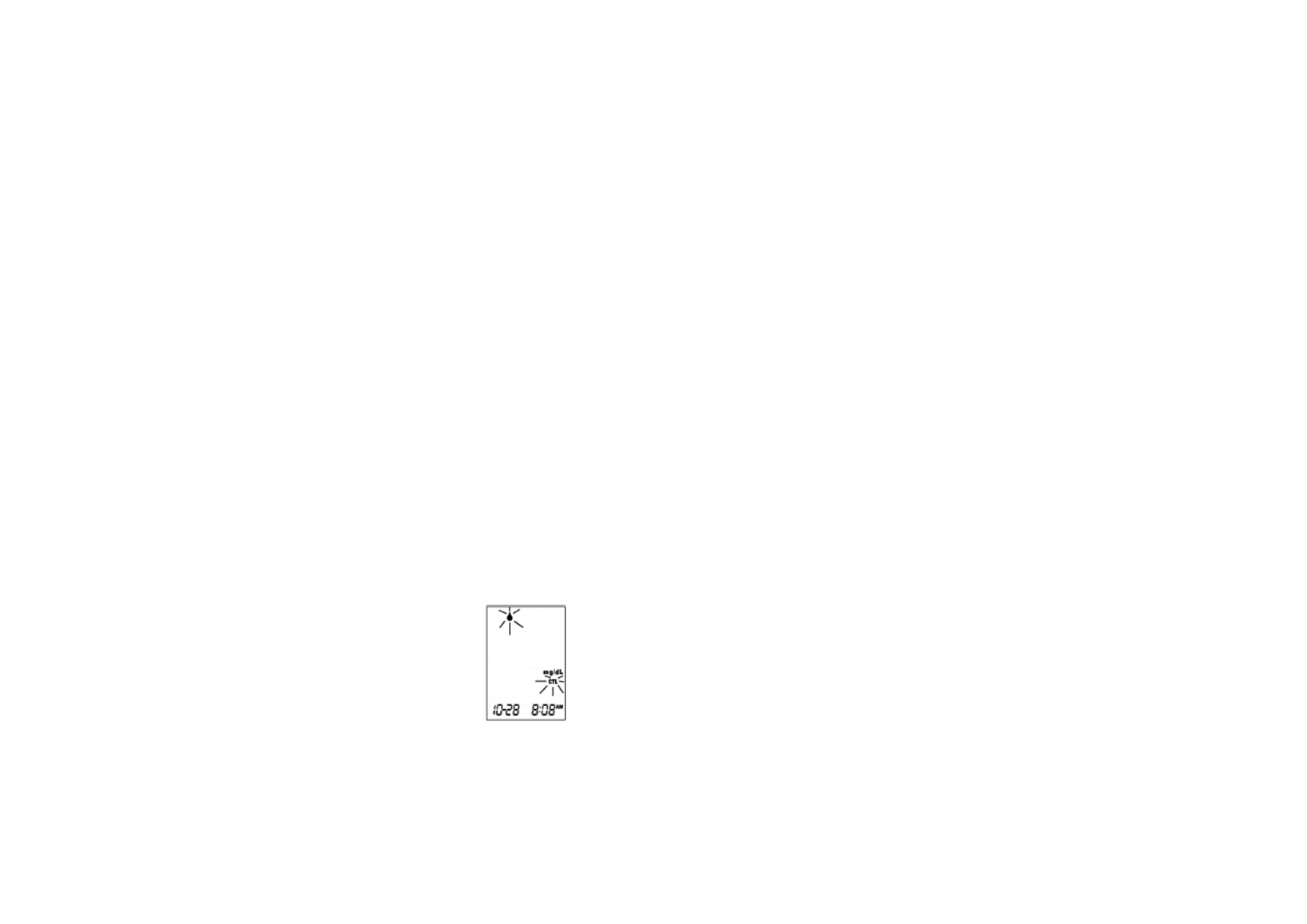
Page 11 of 19
CONTROL SOLUTION TEST
Material needed:
Glucose Meter
Test strips
TaiDoc Control solution
When to do a control solution test
When you suspect that the meter or test strips are not working properly.
If your blood glucose test results are not consistent with how you feel.
After the test strips are exposed to extreme conditions.
After dropping the meter.
The control solution is to check that the meter and the test strips can work
together as a system and work correctly.
How to do a control solution test
Step 1
Insert the test strip into the meter. Wait for the meter to display the drop
symbol.
Step 2
You may press “S” button to select CTL mode, for
selecting the CTL mode, please refer to the “The two
measuring modes” section.
Step 3
Apply the control solution
Shake the control solution vial thoroughly before use.
Squeeze out a drop and wipe it off, then squeeze another drop and place it on
the tip of the vial cap.
Hold the meter to move the absorbent hole of test strip so it touches the drop.
Once the confirmation window fills completely, the meter will begin counting
down.
To avoid contaminating the control solution, do not directly apply control
solution onto a strip.
Step 4
The result of the control solutions test appears on the display. The result will
not be stored under CTL mode.
The result of the control solutions test should be within the range printed on the
test strip vial label. If the test results falls outside the specified range printed on
test strip vial label, repeat the test. Results falling outside the specified range
may be caused by:
Error in performing the test
Expired or contaminated Control Solution
Expired or contaminated Test Strip
Malfunction of your Meter
If you continue to get control solution test results that fall outside of the range
printed on the vial, the system may not be working properly, Do not use the
meter. Please contact your customer support immediately
NOTE:
Do not use the expired control solution. Only use the TaiDoc control
solution, you can purchase this product through visits the website:
www.taidoc.com.
Users should periodically review their technique and compare a result
obtained with their meter to a result obtained using a laboratory method or
a well-maintained and monitored system used by your healthcare provider.
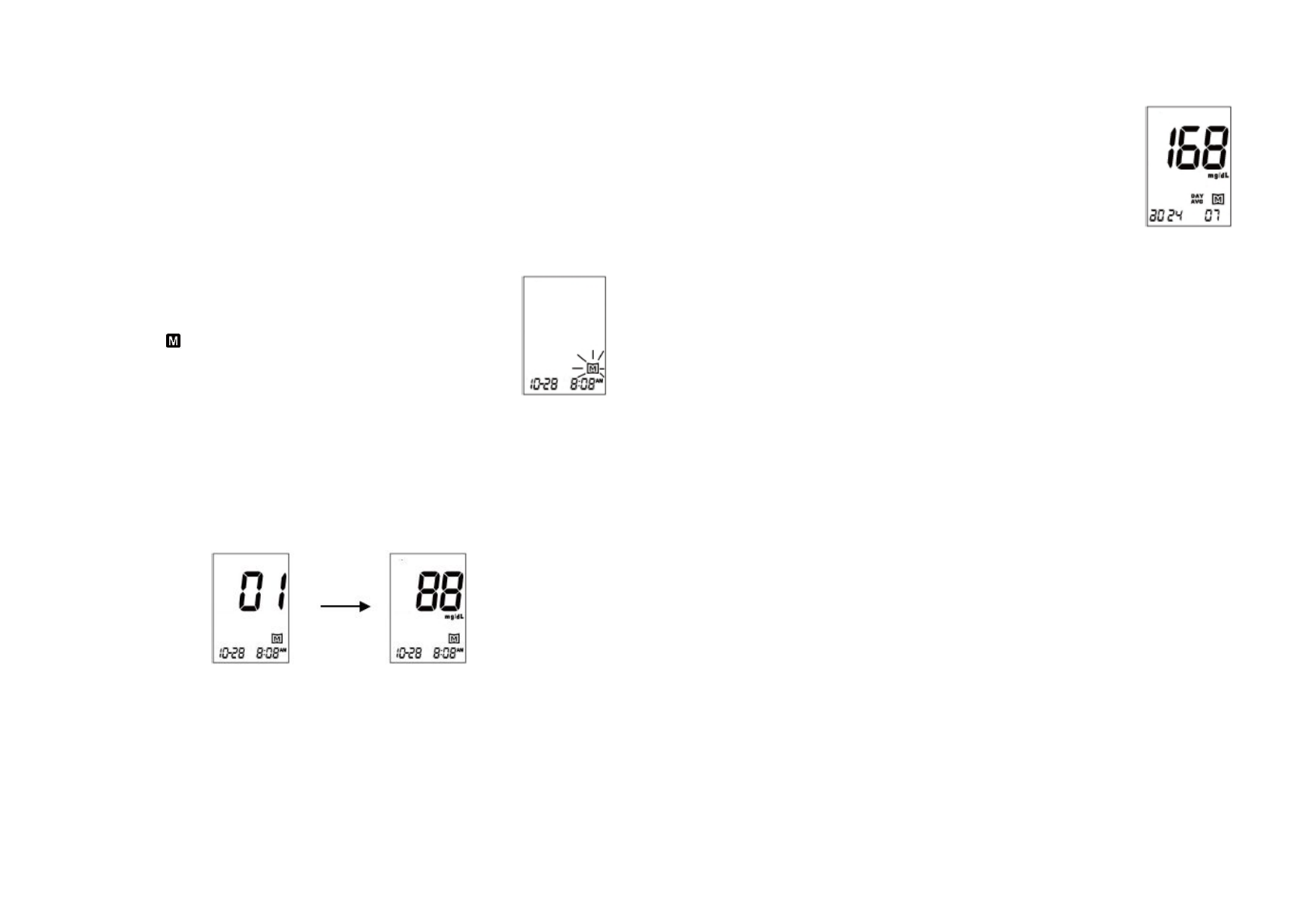
Page 12 of 19
Viewing Results on the Meter
Your meter stores the 500 most recent blood glucose test results with dates and
times. It also provides 7-, 14-, 21-, 28-, 60- and 90-day averages of your blood
glucose test results.
Note: The control solution readings are not included in the average of your
results.
Recalling the Stored Test Results
1. Start with the meter off, press the “M” button to turn on the
meter. The “ ” symbol will flash with the time and date
displayed on the screen.
2. Press “M” again, the most recent test results with date and time will display.
Press “M” once more and the next most recent test results will appear. Each
time you press and release “M”, the meter will recall up to your last 500 test
results in order. Press the “S” to turn off the meter. When the memory is full,
the oldest result is dropped and the newest result is added.
Reading the Average of Blood Glucose Results
When the meter is off, press and hold the “M” button until the
DAY AVG flashing, release button then 7-day average results
appear with “n024” (means 24 records to be averaged) on the
screen. Press the “M” button to review the 14-, 21-,28-, 60- and
90-day general averages. Press the “S” button to turn off the
meter.
Note: The control solution readings are not included in the average of your results.
When your glucose value is less than 20mg/dL, you will see the following message
“Lo”; When your glucose value is high than 600mg/dL, you will see the following
message “HI”
Care and storage for your system
Handle the meter with care. Dropping or throwing the meter may cause
damage to the device.
Don't expose the Blood Glucose Monitoring System, Test strip, and Control
Solution, to extreme conditions, such as high humidity, heat, freezing cold or
dust. The storage conditions for the test strips are 39 ℉~86℉, Humidity <
80%RH. Storage conditions for the meter are -40 ℉~131 ℉, Humidity <
80%RH.
Always wash your hands with soap and water and rinse and dry completely
before handling the Blood Glucose Monitoring system and Test strip.
Use CaviWipes (see below) to clean the Blood Glucose Monit oring System.
Discard the used lancet into a container for sharp objects.

Page 13 of 19
Cleaning and Disinfection
The cleaning and disinfection is absolutely necessary for the test procedure,
because cleaning can insure the meter works well (for example, display will be
clear to see after cleaning); and disinfection can avoid the infection to you or to the
other people, and the cross-infection. We strongly warn that the device should be
cleaned and disinfected following use on every patient. And we suggest you use
the following product: CaviWipes (EPA registration number:46781-8). You can
purchase this product according to the following information: visit the web site:
www.metrex.com or contact Metrex at 800-841-1428 for product or technical
information. CaviWipes are also available at www.amazon. com or via a Google
search.
The meter for single-patient use and the lancing devices may be cleaned 5-6 times
per day (Test 5-6 times every day), so the meter will be cleaned and disinfect about
11000 cycles that include cleanings plus disinfections (1 cycle = 1 cleaning + 1
disinfection) during its 5 years life cycle.
1. Before the test, the user should clean and wash hands. If you are a caregiver,
(not the patient), please use disposable gloves.
2. After test, take one wipe to clean the meter’s housing, buttons, lens, mark, usb
cover and support block, including its front and back for 10 seconds for cleaning
until there is no soil on the surface. Then disinfect the meter’s housing, buttons,
lens, mark, usb cover and support block use another wipe for 2 min, keep the
surface wet for 2 min.
3. Take off the glove; discard carefully according to your health-care provider’s
instruction.
Note:
1. Each disinfection step requires a pre-cleaning step.
2. If the meter is being operated by a second person who is providing testing
assistance to the user, the meter and lancing device shall be cleaned and
disinfected first.
3. The users should wash hands thoroughly with soap and water after handling the
meter, lancing device, or test strips.
Specification
1. Model: G-427B
2. Machine size: 90mm (L)×54mm (W)×13mm(H)
3. Weight: 73g (excluding batteries)
4. Measuring method: Amperometric technology using glucose oxidase
5. Measuring range: 20 mg/dL ~600 mg/dL
6. Memory: 500 blood glucose tests
7. Display: LCD display with backlight
8. Power source: DC 3V (AAA×2 alkaline batteries)
9. Battery Life: Approx. 500 normal tests
10. Storage Condition (system: meter and test strips): 39.2℉~104 ℉and below
85% relative humidity
11. Storage Condition (meter): -40 ℉~131 ℉,Humidity <80%RH, 700hPa ~
1060hPa
12. Operating conditions: 50℉~104℉, Humidity:25%~80%RH
13. Blood Source: Fresh capillary whole blood
14. Blood Volume: Minimum 0.7 micro liter.
15. Use life: five years.
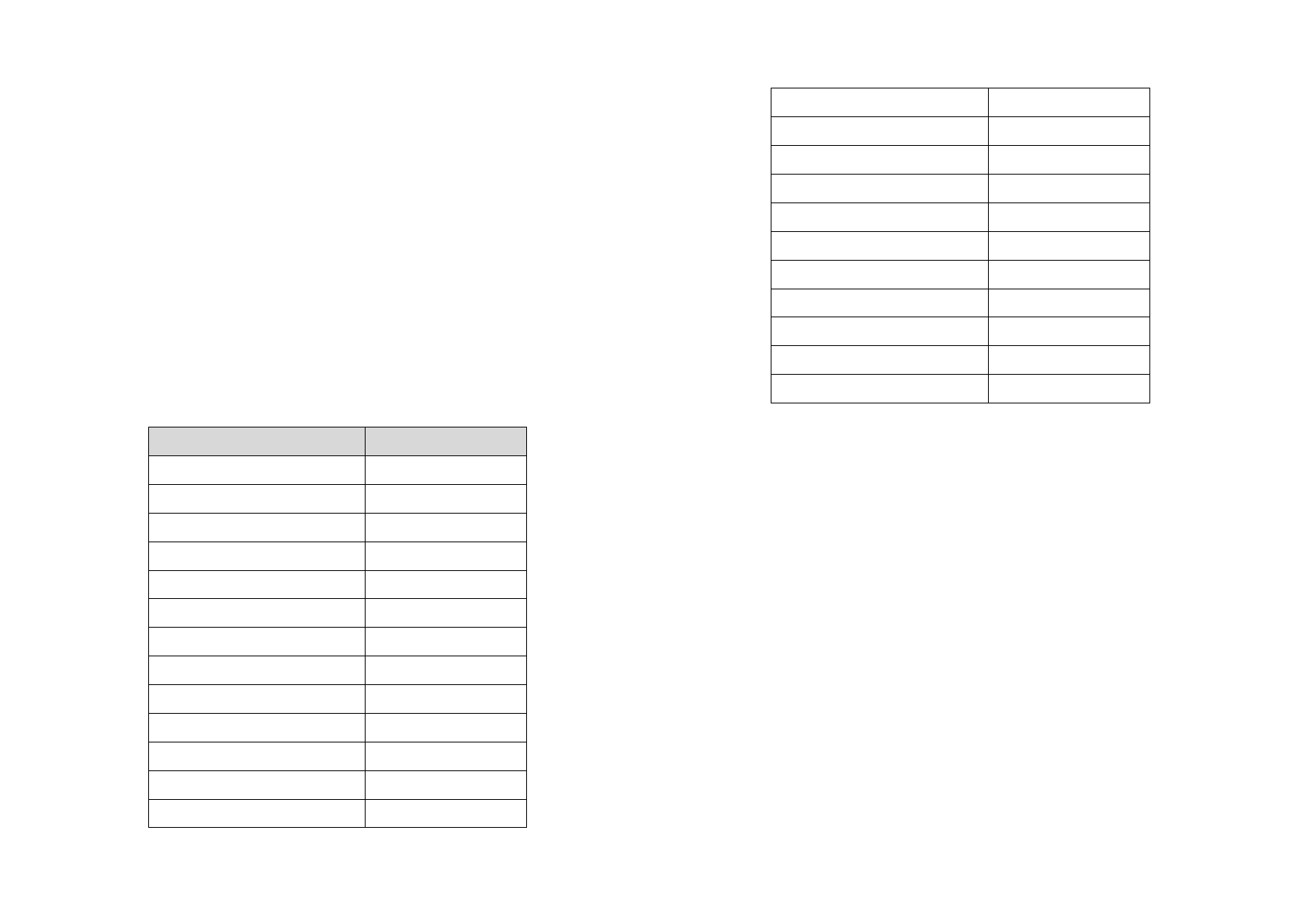
Page 14 of 19
Limitations of use:
The blood Monitoring System is not intended for use on neonates.
The blood Monitoring System is not intended for use on artery blood,
neonates’ serum and plasma.
The system can be used up to an altitude of 10744 feet.
The following substances at levels greater than normal or therapeutic levels
may cause significant interference (affect the result by greater than 10%)
resulting in an inaccurate result: ascorbic acid, uric acid, hemoglobin ,
acetaminophen, Dopamine, L-dopa, L-dopa and Tolbutamide etc. These sub-
stances do not affect test results in normal concentration but may affect test
results in high concentration. Do not use haemolysis sample, icterus sample
or high lipemia samples.The following compounds, when determined to in
excess of their limitation, may produce inaccurate results:
Compound
Limitation
1. Acetaminophen
≤ 8.0 mg/dL
2. Ascorbic Acid
≤ 5.0 mg/dL
3. Bilirubin
≤ 90 mg/dL
4. Cholesterol
≤ 500 mg/dL
5. Creatinine
≤ 5.0 mg/dL
6. Dopamine
≤ 2.0 mg/dL
7. EDTA
≤360 mg/dL
8. Galactose
≤ 900 mg/dL
9. Gentisic Acid
≤ 5.0 mg/dL
10. Glutathione
≤53 mg/dL
11. Haemoglobin
≤500 mg/dL
12. Heparin
≤8000 U/dL
13. Ibuprofen
≤50 mg/dL
14. Icodextrin
≤13 mg/dL
15. L-dopa
≤ 10 mg/dL
16. Maltose
≤ 900 mg/dL
17. Methyldopa
≤ 3.0 mg/dL
18. Pralidoxime Iodide
≤25 mg/dL
19. Salicylate
≤60 mg/dL
20. Tolazamide
≤100 mg/dL
21. Tolbutamide
≤ 400 mg/dL
22. Triglycerides
≤ 2000 mg/dL
23. Uric Acid
≤ 8.0 mg/dL
24. Xylose
≤100 mg/dL
Patients undergoing oxygen therapy may yield falsely lower results.
Not for use for patients in a hyperglycemic-hyperosmolar state, with or
without ketosis.
Not for use on critically ill patients.
Not to be used for patients who are dehydrated, hypertensive, hypotensive or
in shock.
Very low (less than 20%) or very high (more than 60%) red blood cell count
(hematocrit) can lead to incorrect test results. If you do not know your
hemarocrit level, please consult your health care provider.
High temperature (more than 104 ℉) and low temperature (less than 50℉)
may lead to incorrect test results.
High humidity (more than 80%) and low humidity (less than 25%) may lead
to incorrect test results.
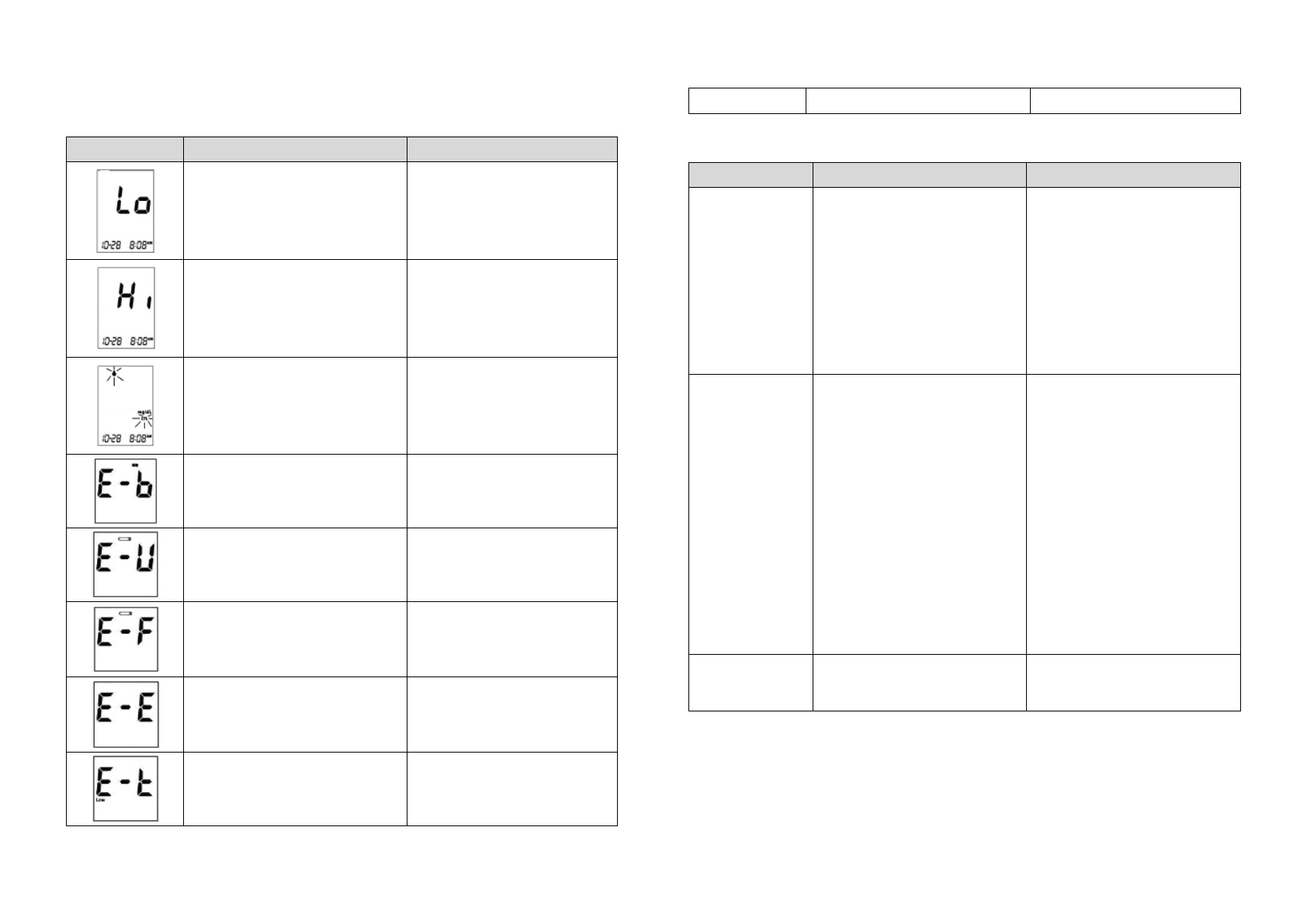
Page 15 of 19
DISPLAY MESSAGE
MESSAGE
WHAT IT MEANS
ACTION
Blood glucose level is lower
than 20mg/dl
The message indicates very
low blood sugar. You should
consult with your healthcare
professional.
Blood glucose level is higher
than 600 mg/dl
This indicates sever
hyperglycemia (high blood
glucose).You should seek
imme- diate medical
assistance.
Meter is ready to test control
solution under the CTL state.
Please place a drop of
control solution onto the test
well of test strip.
Battery power is low.
Please change the
battery.
Use a used test strip
Please use a new strip and
re-test
Error massage indicates that
you may remove prematurely
the strip afeter applying blood
to the absorbent hole
Try again with a new test
strip
Problem with the meter
Re-test with a new test strip.
If the problem is still
unsolved, please call the
customer care line for help.
Environmental temperature is
lower than 50℉~104℉
Please test at an
environmental temperature
within 50℉~104℉operation
range
Problems
Problems
Causes
Solutions
Display remains
blank after the
test strip has
been inserted
into the Meter.
11. Battery may be installed
improperly.
22. Battery power is too low tor
use.
33. Too much time has passed
between inserting the Test
Strip and perfor- ming the
test.
44. Test Strip has not been fully
inserted into the Meter.
1.Install the Battery
correctly.
2.Replace with new Battery.
3.Reinsert the Test Strip into
the Meter.
4.Reinsert the Test Strip into
the Meter.
Test results are
incon sistent or
Control
Solution test
results are not
within
the specified
range.
11. Not enough sample in the
Test Strip.
2. Test Strip or Control
Solution has expired.
33. Test Strip has been damaged
due to heat or humidity so
that sample cannot be applied
or the speed of applying
sample is too slow.
44. System is not per- forming
due to the environment being
above or below room
temperature.
1. Redo test with new test strip
and make sure that enough
sample has been added.
2. Redo test with new test
strip.
3. Perform a Control Solution
test using a new Test Strip. If
results are still out of range,
replace with new vial of Test
Strips.
4. Bring System to a room
temperature environment and
wait approximately 30
minutes before per- forming a
new test.
The Meter
countdown did
not start.
Test Strip has not been
inserted correctly.
Use a new Test Strip and redo
the test.
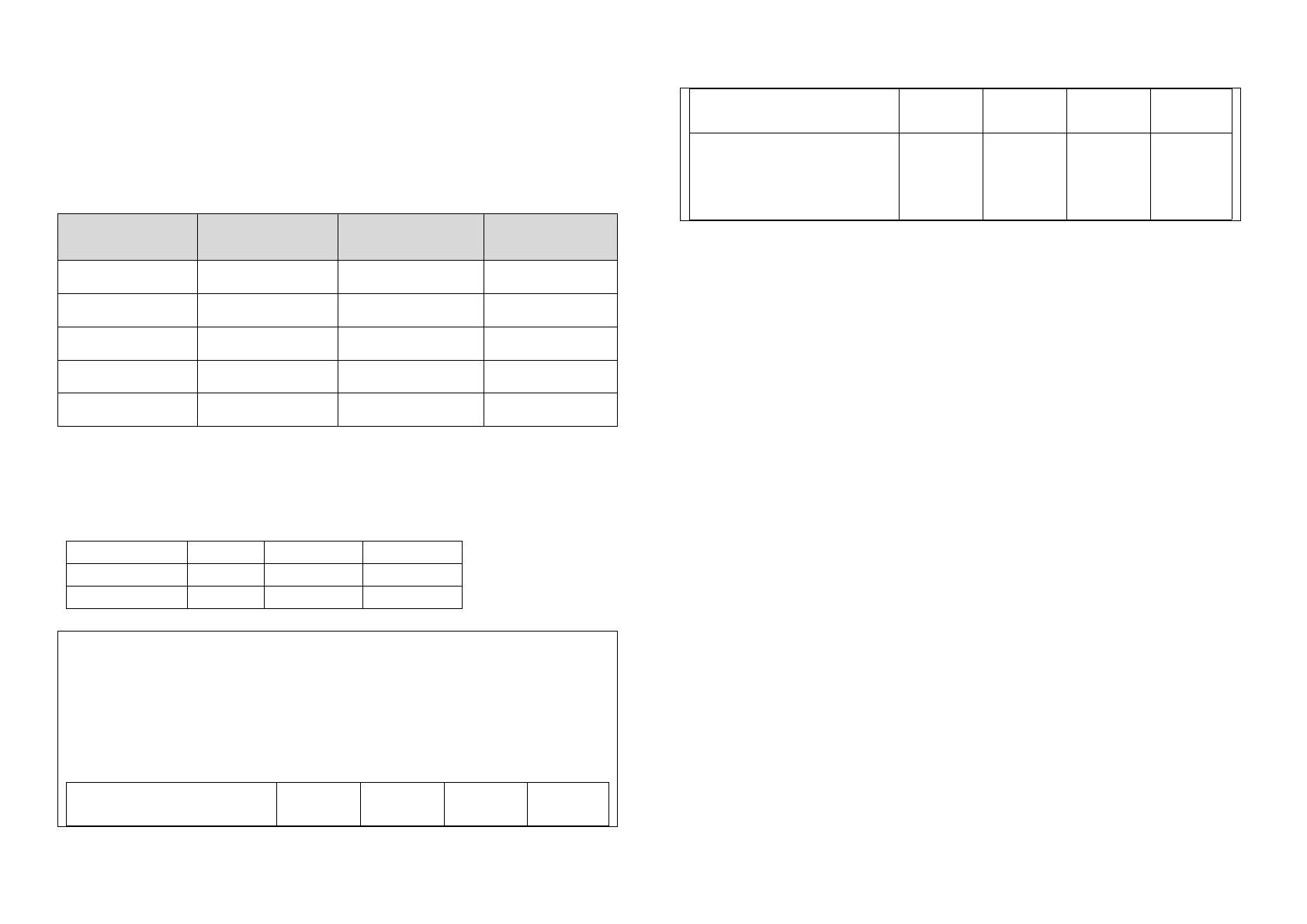
Page 16 of 19
Performance Characteristics
Precision
Within Run Precision (300 Venous Blood Tests per Glucose Level)
Target Glucose
(mg/dL)
Mean Glucose
(mg/dL)
Standard Deviation
(mg/dL)
Coefficient of
Variation (%)
Results show that the greatest variability observed between test strips when tested
with blood is 2.44% or less.
Intermediate precision
Mean (mg/dL)
44.4
108.1
342
SD (mg/dL)
3.2
3.3
7.1
CV (%)
-
3.3
2.0
Your G-427B Meter result may vary slightly from you actual blood glucose value.
This may be due to slight differences in technique and the natural variation in the
test technology.
The chart below shows the results of a study where 350 typical users used the
G-427B meter to test their blood glucose level. In this study, the G-427B meter
gave result within 15% of their true blood glucose level 340 out of 350 times.
Difference range between
the true blood glucose level
Within
5%
Within
10%
Within
15%
Within
20%
and the G-427B meter
result
The percent(and number) of
meter results that match true
blood glucose level within
x%
Traceability of glucose monitoring system
The results of G-427B blood glucose monitoring system were compared to parallel
results obtained on YSI-2300, which is the manufacturer's standard measurement
procedure.
BIOLAND TECHNOLOGY LTD.
No. A6b7 (Block G) ShangRong Industrial Zone No. 5 Baolong Road, Baolong
Community Longgang District 518116, Shenzhen, Guangdong PEOPLE’S
REPUBLIC OF CHINA
Toll free telephone number: 8002182838

Page 17 of 19
Electrical and safety standards
This meter complies with CISPR 11: Class B (Radiated Only). Emissions of the
energy used are low and not likely to cause interference in nearby electronic
equipment. The meter has been tested for immunity to Level 3 electrostatic
discharge as specified in IEC 61326. This meter complies with immunity to radio
frequency interference over the frequency range 80MHz to 2.5GHz at 3V/m as
specified in IEC 61326-1 or 61326-2.
The meter meets the requirements for immunity to electrical interference at the
frequency range and test level specified in international standard ISO 15197.
Use of this meter near electrical or electronic equipment that are sources of
electromagnetic radiation, may interfere with proper operation of this meter. It is
advisable to avoid testing in close proximity to sources of electromagnetic
radiation.
Common sources of electromagnetic radiation includes mobile phones, walkie
talkies or garage door openers.
Do Not use the equipment where aerosol sprays are being used, or when oxygen is
being administered.
FCC Requirement
changes or modifications not expressly approved by the party responsible for
compliance could void the user’s authority to operate the equipment.
This device complies with Part 15 of the FCC Rules. Operation is subject to the
following two conditions:
(1) this device may not cause harmful interference, and
(2) this device must accept any interference received, including interference that
may cause undesired operation.
Note: This equipment has been tested and found to comply with the limits for a
Class B digital device, pursuant to Part 15 of the FCC Rules. These limits are
designed to provide reasonable protection against harmful interference in a
residential installation. This equipment generates, uses, and can radiate radio
frequency energy, and if not installed and used in accordance with the instructions,
may cause harmful interference to radio communications. However, there is no
guarantee that interference will not occur in a particular installation. If this
equipment does cause harmful interference to radio or television reception, which
can be determined by turning the equipment off and on, the user is encouraged to
try to correct the interference by one or more of the following measures:
–Reorient or relocate the receiving antenna.
–Increase the separation between the equipment and receiver.
–Connect the equipment into an outlet on a circuit different from that to which
the receiver is connected.
–Consult the dealer or an experienced radio/TV technician for help.
This equipment complies with FCC radiation exposure limits set forth for an
uncontrolled environment. This equipment should be installed and operated with a
minimum distance of 20cm between the radiator & your body. This transmitter
must not be co-located or operating in conjunction with any other antenna or
transmitter.